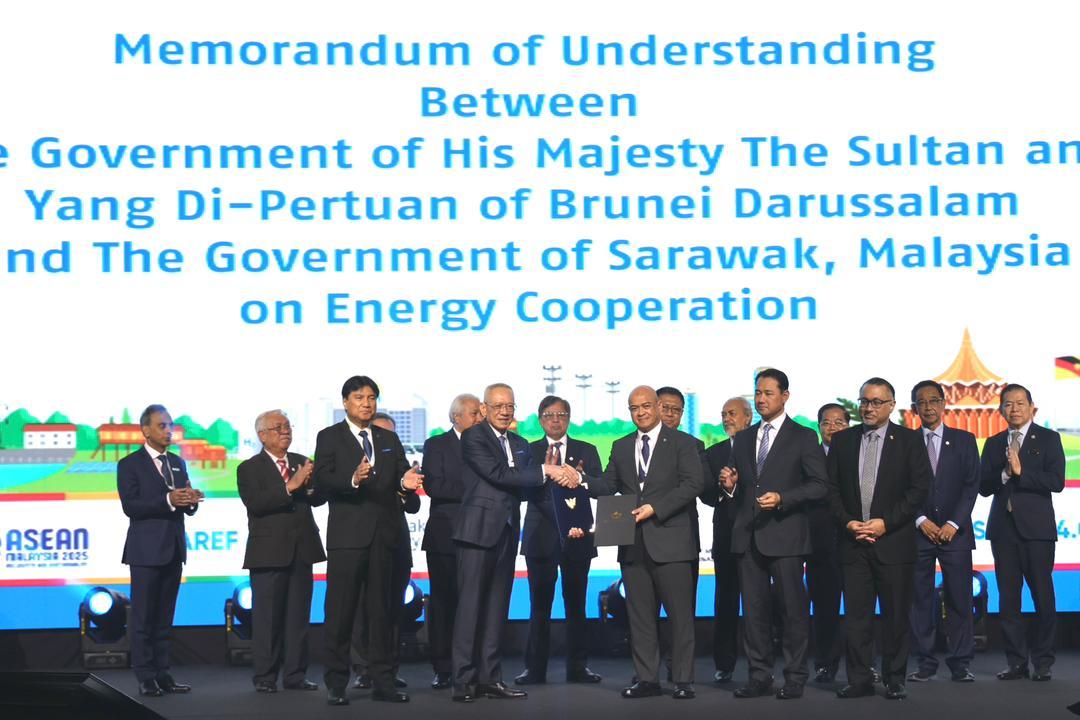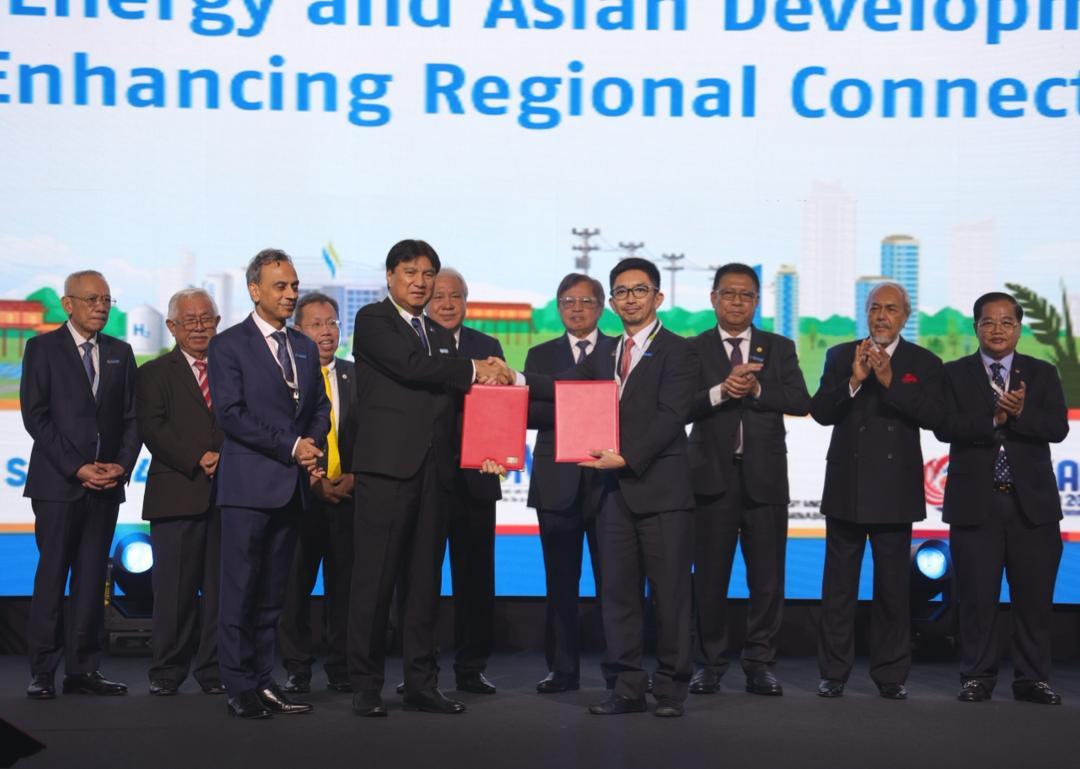MOU between Brunei Darussalam and Sarawak. The exchange was witnessed by Sarawak Premier Datuk Patinggi Tan Sri Abang Johari Tun Openg with Deputy Minister of Energy Dato Seri Paduka Awang Haji Mohamad Azmi Haji Mohd Hanifah representing Brunei Darussalam and Deputy Minister for Utility and Chairman of Sarawak Energy Datuk Ibrahim Baki, representing Sarawak. Photos courtesy of Sarawak Energy.
The Malaysian state of Sarawak is strengthening its position as a renewable energy hub through strategic partnerships. Last week’s Sustainability and Renewable Energy Forum in Kuching witnessed the exchange of two memorandums of understanding (MOU).
The first MoU is between the Government of His Majesty the Sultan Haji Hassanal Bolkiah and Yang Di-Pertuan of Brunei Darussalam and the Government of Sarawak on energy cooperation. It establishes collaboration in the energy sector to support sustainable economic growth and development. The scope of cooperation includes capacity building and knowledge and expertise sharing; research, exploration, development, and production; and the exchange of best practices in energy policy.
The second MoU is between Sarawak Energy Berhad and the Asian Development Bank (ADB). It formalizes a partnership on cross-border power connectivity. The collaboration will cover and support technical studies, feasibility work, capacity building and funding mechanisms, which are expected to boost Sarawak’s interconnection capabilities and support wider regional energy cooperation under the ASEAN Power Grid, including for the Sarawak–Singapore Interconnection Project.
The ADB-managed ASEAN Catalytic Green Finance Facility (ACGF) will support several technical studies with a financial contribution from the Government of the United Kingdom.
Focus on collaboration
The theme of the 2-day forum, a flagship event of Sarawak Energy, was on partnerships.
At the event, the Minister for Utility and Telecommunication Dato Sri Haji Julaihi Haji Narawi said Sarawak is being positioned as a regional supplier of clean and competitively priced electricity in Southeast Asia.
Sarawak wants to maintain at least 60% renewable capacity mix by 2030. It is rich in hydropower and plans to increase capacity to 4,800 megawatts from 3,500 megawatts. It is also targeting 1,500 megawatts of solar capacity. The state is also being developed by the government as a regional green hydrogen hub.
Julaihi added that efforts to advance policy, technical, and commercial frameworks will enhance grid connectivity toward the ASEAN Power Grid, enabling more resilient, sustainable, and integrated energy systems across the region.
ASEAN’s vision is to connect the electricity networks of its 10 member countries and achieve fully integrated grid operations by 2045. The ASEAN Power Grid will ensure a reliable and affordable energy supply and maximize the use of renewables through cross-border power trading. Over the past 2 decades, ASEAN member states have been pursuing grid interconnection and cross-border power trade through bilateral and subregional initiatives.
Energy cooperation between Brunei Darussalam and Sarawak has been ongoing. This includes plans for grid-to-grid interconnection through a 275-kilovolt high-voltage alternating current (HVAC) overhead transmission line from the Tudan substation in Miri, Sarawak to Kuala Belait and Lumut in Brunei Darussalam. The project is in the feasibility stage.
Sarawak’s first cross-border transmission link is with West Kalimantan in Indonesia. The ADB-supported Trans Borneo Power Grid Sarawak–West Kalimantan Interconnection, a priority infrastructure project of BIMP-EAGA, was commissioned and energized in January 2016. The 275 kV grid-to-grid connection enables Sarawak to export up to 230 megawatts (MW) of hydropower to West Kalimantan.
Mobilizing financing
Based on the ASEAN Interconnection Masterplan Study (AIMS III) in 2021, the region needs more than $16 billion alone to connect the electricity networks of ASEAN’s 10 member countries. The interconnection project linking Sarawak to Singapore via a submarine cable with a capacity of up to 1,000 MW is not yet included in the masterplan.
ADB announced earlier that it is ready to commit up to $10 billion of its own resources toward the ASEAN Power Grid to expedite cross-border connections, domestic grid strengthening and modernization, and renewable energy initiatives that will facilitate power trade. It will provide technical assistance and financing to support project preparation and capacity building.
Together with the World Bank, ASEAN Secretariat, and ASEAN Centre for Energy, ADB is also leading the ASEAN Power Grid Financing Initiative (APGF), a dedicated coordination mechanism that will facilitate collaboration between countries, the private sector, financiers, and development partners.
The second MoU was exchanged between Sarawak Energy and the Asian Development Bank (ADB) to formalize a partnership on cross-border power connectivity. Sarawak Energy’s Group Chief Executive Officer Datuk Haji Sharbini Suhaili and ADB's Director for the Energy Sector Keiju Mitsuhashi, represented the two parties at the exchange.

